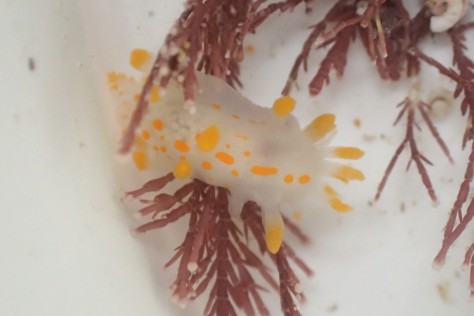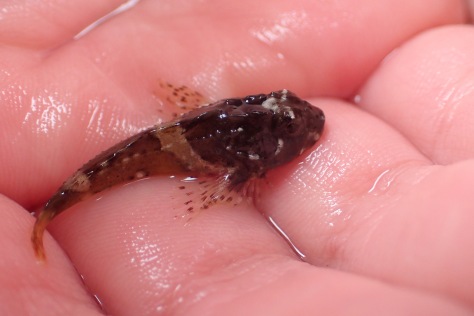It’s the middle of the night and I’m convinced there’s something wrong with my eyes. I’ve unplugged my phone, tried blinking several times but I’m still seeing flickering lights and flashes. Finally I twig what’s going on and open the curtains to reveal incessant sheet lightning.
My first thought is that it had better stop by the morning, else no-one will turn up to my first rock pooling event at Porth Mear with Fox Club, the junior branch of the Cornwall Wildlife Trust. As a child, I was a keen member myself so I’ve been looking forward to this for months.
By the morning the lightning storm has given way to wind and rain, but conditions are less than inspiring. It’s amazing anyone shows up for rock pooling, but a few hardy well-wrapped-up folk do, as does a lovely volunteer assistant. In the chill wind at Pentire Farm car park my faith in the weather wavers, but we’re here now. There’s nothing for it but to grab the buckets and set out.
As soon as I see the bay, I know it’s going to be fine. The cliffs are sheltering the pools and the waves are dashing themselves out against the rocks on the western side of the cove. The cloud thins, the temperature lifts. It’s a perfect day for rockpooling.
Within minutes of hitting the pools, a little girl brings over the first sea hare. We watch it unfolding its long ‘ears’ in the tub and she’s delighted with it, announcing it to be far nicer than garden slugs.

She’s barely returned to the pool before she’s back again with a gorgeous baby spiny starfish on some kelp. When I turn the seaweed over I realise she’s also brought me an even tinier baby cushion star. The kids squeal at its cuteness. It’s going to be a magical day!

The finds flood in. There are Green shore crabs, Xantho pilipes (hairy-legged ‘pebble’ crabs), including some females with eggs tucked under their tails. There are hermit crabs, brittle stars and lots more sea hares. The seaweed-packed pools are providing the perfect conditions for sea hares to get fat and start spawning.
Sure enough, we find the pink spaghetti eggs of the sea hare in a pool.

Even more excitingly, when one of the mums rescues a sea hare that is stranded on a rock, drying out fast, it assumes it’s being attacked and squirts out purple ink. We gather round to watch the jet of ink in the tub which soon turns the water purple.

We’re all looking out for the St Piran’s hermit crab (Clibanarius erythropus) and sure enough we find several large colonies of them. They first re-arrived here last year after an absence of around 40 years.

There are plenty of the common hermit crabs (Pagurus bernhardus) too. The species are easy to tell apart, as the common hermit has yellow eyes and a right claw much bigger than the left, whereas the St Piran’s crab has black and white eyes, equal sized claws and red, hairy legs.
I keep asking if they’ve had enough, given that it’s past lunch time, but they’re keen to carry on. I’m impressed by how knowledgeable everyone is already and how good they all are at taking care of the animals they find. There might well be some future marine biologists in this group.

The finds keep flooding in. There’s a smart little Aeolidia papillosa ‘sheep’ slug, which has turned from white to browny-red after eating an anemone.

On the lowest part of the shore I find a yellow-clubbed sea slug (Limacia clavigera).

Best of all, among the many fish eggs I see under the rocks, there’s a sea slug feeding on a patch of goby eggs. It’s the rare Calma gobioophaga that I only recorded for the first time last week. It’s so impossibly small and well-camouflaged that the children need to view it on my camera to even see that it’s there.

By the time I return to our ‘shore laboratory’ to talk through our finds at the end of the session, it’s teeming with colourful anemones, painted top shells and many more lovely creatures. Everyone has done a good job of keeping the animals comfortable and safe, with crabs in separate buckets to prevent any injuries to the animals.
The kids show me their favourite finds and we talk about each of them and practice handling them safely. There are enough starfish for all the children to hold one at the same time. The fish are popular too and we have a good selection of species to look at; a shanny, rock goby, Cornish clingfish and a baby sea scorpion.

Before the tide turns, everyone helps out with carrying creatures back to the pools where we found them.

It must be getting on for 2pm by the time Junior and I reach the top of the bay and sit on the sand for a quick sandwich. It’s been a perfect day despite the iffy weather at the start and I hope that the children will remember it as well as I remember my own Fox Club trips. Who knows, perhaps Junior and his new friends will be back here leading an event some day?


Absolutely brilliant Heather. I shall spread the link far and wide to.those that attended and to our volunteers. Thank you for an.incredibly awesome Fox club event xxx
Sent from my Windows 10 phone
LikeLiked by 1 person
Thanks Jo – I hope the kids enjoyed it as much as I did. All the families who came were amazing and we found some very cool creatures. 🙂 xx
LikeLike
How amazing, wish I had been there. Thanks for the post I learned a lot (hope I remember the names when I next rock pool) and wonderful photos.
LikeLiked by 1 person
Thanks Kath. I hope you can come along to an event sometime. Enjoy your rock pooling and let me know what you find 🙂
LikeLike
Another excellent post. Not many rock pool sites in Norfolk, only one that I can think of. If only you were here, I could discover some interesting things in a Norfolk rock pool with your help.
LikeLike
Thanks Sean. I’d love to explore the Norfolk coast sometime – and you should definitely come down to Cornwall too. I always love reading your posts too – they’re fantastic and always full of species and places that are so different from what we see here. Keep them coming!
LikeLike
Fantastic blog Heather! I will share with my shoresearch Volunteers! Love Porthmear!
LikeLike
Thanks Matt – it was great to take the Fox Club down there. Reminds me of my youth! 😀 Yes please, share away! And make sure to look out for slugs on fish eggs at the moment.
LikeLike